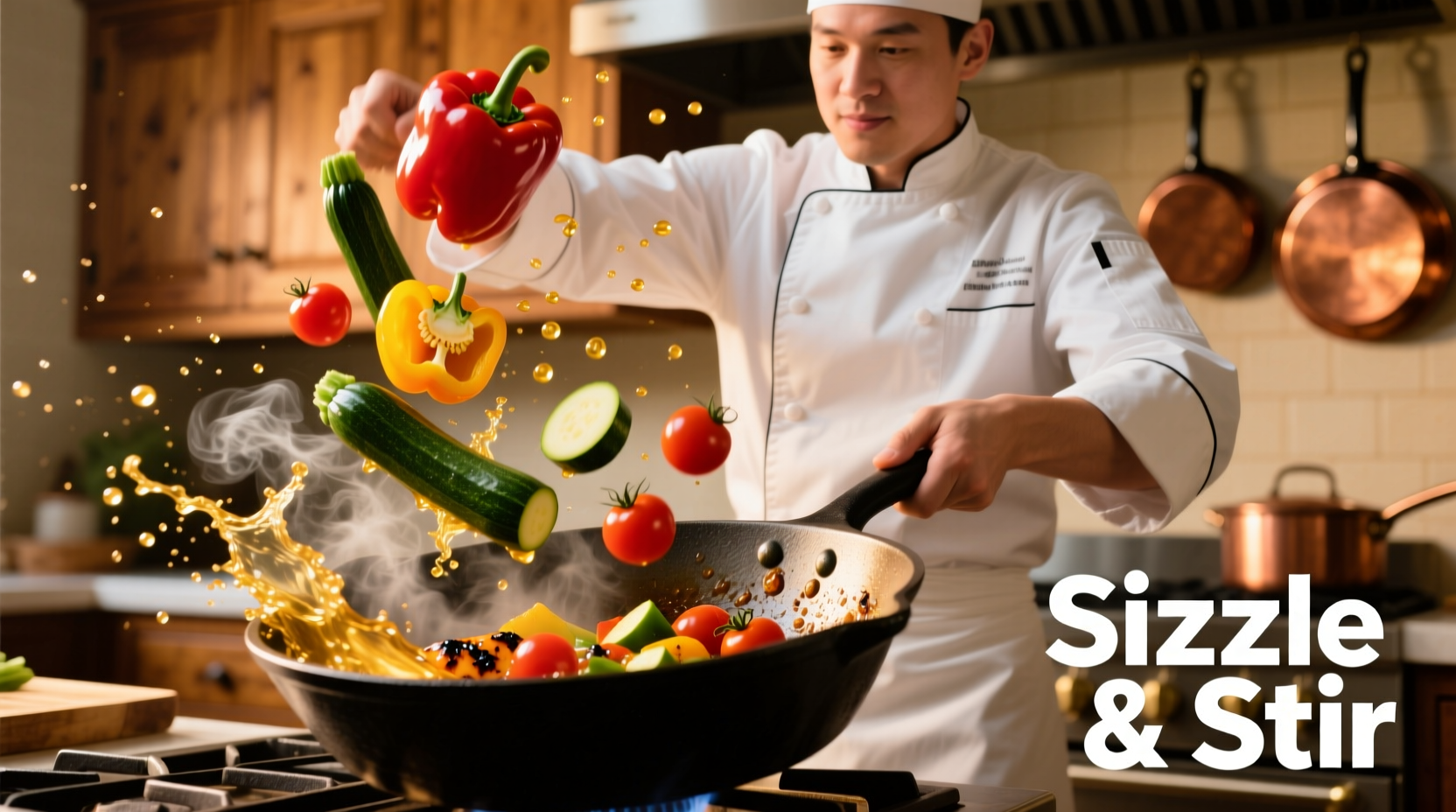Why Proper Vegetable Cooking Matters
Vegetables provide essential vitamins, minerals, and fiber, but improper cooking can destroy up to 50% of their nutritional value. According to USDA research, the right cooking technique preserves antioxidants while improving digestibility. This guide delivers science-backed methods that professional chefs use to transform ordinary vegetables into extraordinary dishes.
The Core Principles of Vegetable Cooking
Before diving into specific techniques, understand these fundamental principles that apply to all vegetable preparation:
- Size consistency matters: Cut vegetables to uniform sizes for even cooking
- Dry vegetables cook better: Pat produce thoroughly before applying heat
- Season in layers: Add salt at multiple stages for balanced flavor development
- Respect natural moisture: Water-rich vegetables (zucchini, tomatoes) need less added liquid
- Acids late, fats early: Add vinegar or lemon juice after cooking; fats help absorb fat-soluble vitamins
Vegetable Cooking Method Comparison
Each cooking technique offers unique benefits and limitations. Choose based on your desired outcome:
| Cooking Method | Best For | Nutrient Preservation | Time Required | Flavor Result |
|---|---|---|---|---|
| Steaming | Delicate vegetables (broccoli, asparagus) | Excellent (water-soluble vitamins retained) | 3-8 minutes | Clean, bright flavor |
| Roasting | Root vegetables (carrots, potatoes) | Good (fat-soluble vitamins enhanced) | 20-45 minutes | Caramelized, complex sweetness |
| Sautéing | Medium-density vegetables (bell peppers, green beans) | Fair (some vitamin loss) | 5-12 minutes | Rich, developed flavors |
| Blanching | Vegetables for salads or freezing (green beans, cauliflower) | Very Good (quick exposure to heat) | 1-4 minutes | Vibrant color, crisp-tender texture |
| Grilling | Summer vegetables (zucchini, eggplant) | Fair (some nutrient loss from high heat) | 8-15 minutes | Smoky, charred complexity |
Step-by-Step Cooking Methods
Perfect Steaming Technique
Steaming preserves water-soluble vitamins better than boiling. Follow these steps for optimal results:
- Use a pot with tight-fitting lid and steamer basket
- Add 1-2 inches of water (never let vegetables touch water)
- Bring water to rolling boil before adding vegetables
- Cook dense vegetables (carrots, potatoes) first, adding delicate ones later
- Season with salt immediately after cooking to prevent sogginess
Vegetable-specific steaming times:
- Broccoli florets: 4-5 minutes
- Asparagus: 3-4 minutes
- Green beans: 5-6 minutes
- Carrot sticks: 6-8 minutes
Professional Roasting Method
Roasting concentrates natural sugars through caramelization. For perfect results:
- Preheat oven to 425°F (220°C) - high heat creates better browning
- Toss vegetables with 1-2 tablespoons oil per pound (not more)
- Spread in single layer with space between pieces
- Roast undisturbed for first 15 minutes to develop crust
- Add acid (lemon juice or vinegar) after roasting, not before
According to research from the USDA Food Research Laboratory, roasting actually increases the availability of certain antioxidants in vegetables like carrots and tomatoes by breaking down cell walls.
Sautéing Like a Pro
Sautéing requires precise heat management. Follow this sequence:
- Heat pan until water droplets dance (medium-high heat)
- Add oil with high smoke point (avocado or grapeseed)
- Wait until oil shimmers but doesn't smoke
- Add vegetables in order of density (onions first, leafy greens last)
- Stir occasionally but not constantly to allow browning
- Finish with a splash of liquid (stock or wine) to create pan sauce

Nutrient Preservation Timeline
Understanding how cooking time affects nutrients helps maximize health benefits:
- 0-3 minutes: Vitamin C begins breaking down (especially in water-based cooking)
- 3-5 minutes: Optimal window for preserving most water-soluble vitamins
- 5-8 minutes: Fiber structure begins softening, improving digestibility
- 8-12 minutes: Fat-soluble vitamins (A, E, K) become more bioavailable
- 12+ minutes: Significant nutrient degradation occurs, especially in boiling
The National Institutes of Health confirms that steaming and microwaving preserve the highest percentage of nutrients compared to other methods, with boiling showing the greatest nutrient loss, particularly for cruciferous vegetables.
Flavor Enhancement Techniques
Elevate your vegetables with these professional flavor-building strategies:
Layered Seasoning Approach
- Before cooking: Toss root vegetables with salt to draw out moisture for better browning
- During cooking: Add aromatics (garlic, shallots) in last 2-3 minutes to prevent burning
- After cooking: Finish with acid (lemon juice, vinegar) and fresh herbs
Flavor Pairing Guide
Match vegetables with complementary flavors for restaurant-quality results:
- Asparagus: Lemon zest, Parmesan, toasted almonds
- Carrots: Cumin, honey, fresh dill
- Broccoli: Red pepper flakes, garlic, anchovy (for umami)
- Green beans: Shallots, bacon, toasted walnuts
- Beets: Orange zest, balsamic, fresh mint
Troubleshooting Common Problems
Soggy Roasted Vegetables
Cause: Too much oil or overcrowded pan Solution: Use just enough oil to coat vegetables (1-2 tbsp per pound) and spread in single layer with space between pieces
Bland Steamed Vegetables
Cause: No seasoning during or after cooking Solution: Add 1 tsp salt to steaming water and finish with flavored butter or herb oil
Burnt Sautéed Vegetables
Cause: Pan too hot or vegetables added before oil is properly heated Solution: Heat pan until water droplets dance, then add oil and wait until it shimmers before adding vegetables
Vegetable-Specific Cooking Guide
Each vegetable has unique requirements. Follow these specialized techniques:
Cruciferous Vegetables (Broccoli, Cauliflower)
These contain sulfur compounds that can become bitter when overcooked. For perfect results:
- Steam for 4-5 minutes until bright green and crisp-tender
- Add a slice of lemon to steaming water to reduce sulfur smell
- Finish with toasted sesame oil and soy sauce for Asian-inspired dishes
Root Vegetables (Carrots, Potatoes, Beets)
Maximize natural sweetness with these techniques:
- Roast at 425°F (220°C) with a pinch of sugar to enhance caramelization
- Par-cook dense roots by microwaving 2-3 minutes before roasting
- Add fresh herbs during last 10 minutes of roasting
Leafy Greens (Spinach, Kale, Chard)
Preserve nutrients and texture with proper technique:
- Saute garlic in oil first, then add greens in batches
- Cook just until wilted (1-2 minutes for spinach, 3-4 for kale)
- Finish with splash of vinegar to balance bitterness











 浙公网安备
33010002000092号
浙公网安备
33010002000092号 浙B2-20120091-4
浙B2-20120091-4